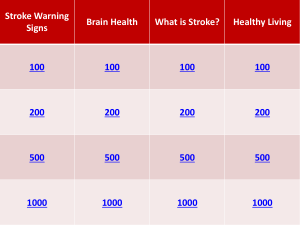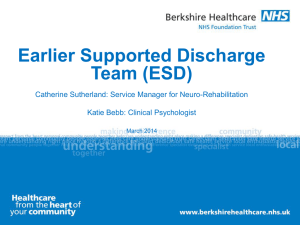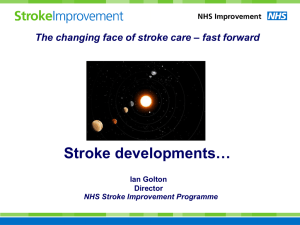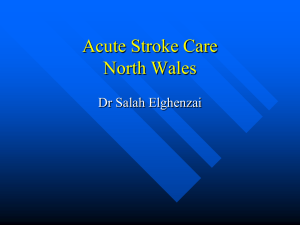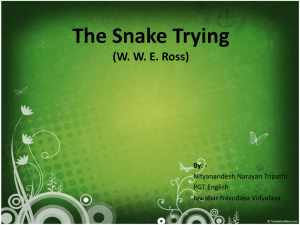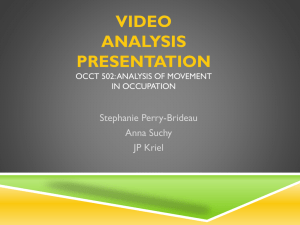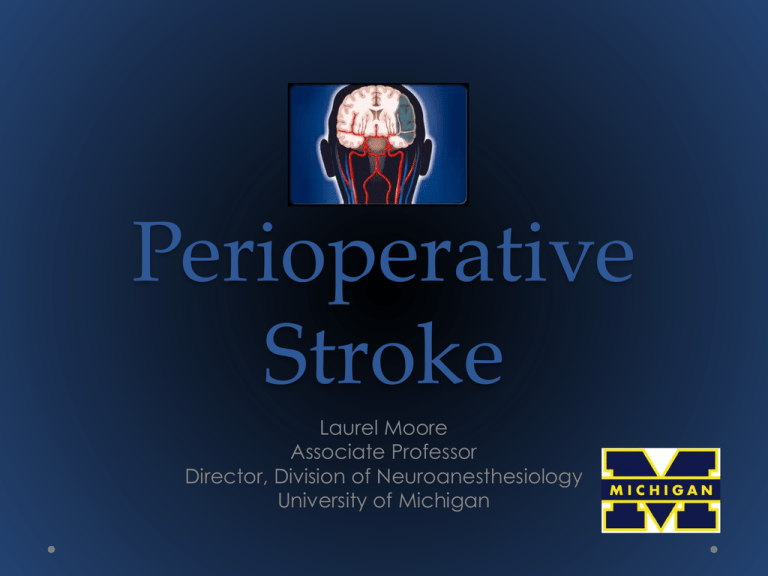
Perioperative
Stroke
Laurel Moore
Associate Professor
Director, Division of Neuroanesthesiology
University of Michigan
Learning Objectives
• Mechanisms and timing of stroke
• Procedures and comorbidities associated with
perioperative stroke
• Clinical management options that may reduce the
incidence of perioperative stroke
• Significance of early recognition and treatment of
stroke in the postoperative patient
Outline of Presentation
•
•
•
•
Brief Review of Perioperative Stroke
Preoperative risk reduction
Intraoperative risk reduction
Postoperative recognition and possible
treatment options
Why care about perioperative stroke?
Perioperative Complication
Incidence (range)%
Myocardial infarction
0.0005-5.1
Stroke
0.1-3.0
Postoperative visual loss
0.1-0.2
Incidence of stroke by
procedure
Surgical Procedure
Incidence (%)
Noncardiac nonneurologic1
0.1
Total hip arthroplasty2
0.2
Vascular noncarotid3, 20
Vascular carotid27
Coronary artery bypass19, 60
Double and triple valve replacement61
Aortic arch procedures with DHA4
0.4-0.8
0.9
2.0-3.1
9.7
19.2
An updated definition of
st
stroke for the 21 century
World Health Organization 1970:
“neurologic deficit of cerebrovascular cause that
persists beyond 24 hours…”
AHA/ASA 2013:
“CNS infarction is defined as brain, spinal cord or
retinal cell death attributable to ischemia, based on
neuropathological, neuroimaging, and/or
clinical evidence of permanent injury.”
Mechanisms of
Perioperative Stroke
Ischemic
Hemorrhagic
Classification of Subtypes of
Acute Ischemic Stroke
(TOAST Stroke 1993;24:35-41)
White, Circulation 2005;111:1327-1331
Watershed Infarction
Bijker, Can J Anaesth 2013;60(2):159-67
Mechanisms of Stroke
Comorbidities:
Perioperative Events:
1. Age
1. Antiplatelet cessation
2. TIA/stroke
2. Statin cessation
3. Renal disease
3. Afib
4. Female sex
4. Hypotension
5. Cardiac disease
5. Dehydration
6. Hypertension
6. Hypercoagulable state
High Risk Procedures:
7. Afib
7. Inflammatory response
8. Tobacco 1. CEA
2. Cardiopulmonary bypass
3. Open heart
4. Aortic Arch
Moore, Neurologic Outcomes of Surgery and Anesthesia, Cambridge Press 2013
Cumulative Risk of Stroke
High Risk ≥ 5 risk factors
Stroke incidence 1.9%, OR 21
Mashour Anesthesiology 2011;114(6): 1289-96
Timing of Stroke in THR
Lalmohamed Stroke 2012;43:3225-3229
Timing of stroke in noncarotid
major vascular surgery
Sharifpour, Anesth Analg 2013;116(2):424-34
Outline of Presentation
• Brief Review of Stroke and Perioperative Stroke
• Preoperative risk reduction
• Intraoperative risk reduction
Postoperativetherapy
recognition and possible treatment
1.• Antiplatelet
options
2. Statin therapy
Aspirin following cardiac surgery
Mangano NEJM 2002;347:1309
Should ASA be discontinued
preoperatively?
Cerebrovascular
Complications
Bleeding
Complications
Effects of antiplatelet
therapy withdrawal
• Rebound in platelet activity with
abrupt cessation
• 5% of nonoperative ischemic stroke
associated with withdrawal of
antiplatelet therapy
• Strokes generally occur within 2 weeks
of antiplatelet cessation
“We should cease offering
TURP in favour of
alternative surgery options
for anticoagulated patients”
British Journal of Urology International 2011
For patients on warfarin who
should receive bridging
therapy?
Patients in atrial fibrillation with h/o
of stroke or TIA within 6 months
Primary and Secondary Stroke
Prevention with Statins
Primary stroke prevention
Secondary stroke prevention
Nassief Stroke 2008;39:1042-1048
As regards perioperative statins:
“Prospective randomized trials…cannot
be performed anymore…because all
vascular patients should receive statin
treatment as secondary prevention of
cardiovascular disease.”
AF Stalenhoef, J Vasc Surg 2009;49(4):1091
Outline of Presentation
• Brief Review of Perioperative Stroke
• Preoperative risk reduction
• Intraoperative risk reduction
• 1.Postoperative
recognition and possible treatment
Anesthetic technique
options
2. Use of β-blockers
3. Blood pressure management
Anesthetics as
Neuroprotectants
Stroke reduced with Neuroaxial
Anesthesia in THR and TKR
Memtsoudis, Anesthesiology 2013;118(5):1046-1058
POISE Trial 2008
Lancet 2008;371(9627):1839-47
Association of perioperative
metoprolol and perioperative stroke
Mashour Anesthesiology 2013
Stroke incidence with anemia
Metoprolol
Atenolol
Bisoprolol
Ashes, Anesthesiology 2013;119(4):777-787
The role of intraoperative hypotension
in postoperative stroke
Bijker Anesthesiology 2012;116(3):658-64
A word about the dangers of
the beach chair position…
“Unusually low blood pressure will
eventually result in neurological damage;
however, the threshold and duration at
which an association might be found
between a perioperative stroke and
hypotension have not been well
investigated. Thus, the exact role of
hypotension in the etiology of perioperative
stroke is still largely unknown.”
Bijker and Gelb
Can J Anaesth 2013;60(2):159-67
Outline of Presentation
• Brief Review of Perioperative Stroke
• Preoperative risk reduction
• Intraoperative risk reduction
• Postoperative recognition and
possible treatment options
Recognition of postoperative
stroke is frequently delayed
Weightman ASA 2012 Abstract A476
40
35
# of Strokes
30
Medical Recognition to
Imaging Time
25
20
Last Known Normal to
Imaging Time
15
10
5
0
0-3
3-8
≤24
≤48
Hours post-surgery
>48
“Time is Brain”
Kidwell Stroke 2004;35:2662-2665
Mechanical Thrombolysis
Suggestions for clinical
management
• Stroke is more common than you think
• When possible continue anti-platelet rx
• Statins and β-blockers should continue
Suggestions for Intraoperative
management
• Blood pressure goals should be
assessed as % variance from baseline
• Prolonged hypotension probably bad
• Normocapnia probably good
• Induced hypotension for beach chair
position definitely bad
• Nitrous oxide okay
Intraop management cont.
• Patients on β-blockers may be
more sensitive to anemia
• Short-acting or β1-selective βblockers when possible
• Glucose levels 80-150 mg/dL
Conclusions
• Perioperative stroke is rare but potentially
devastating
• Associated co-morbidities are well-defined
• Intraoperative associations are not welldefined
• Improved recognition of postoperative
stroke is necessary before acute intervention
can be considered
Perioperative Care of Patients at High Risk
for Stroke after Non-Cardiac, NonNeurologic Surgery: Guidelines from the
Society for Neuroscience in Anesthesiology
and Critical Care
SNACC Task Force on Perioperative Stroke
George A. Mashour MD PhD, Laurel E. Moore
MD, Abhijit V. Lele MD, Steven A Robicsek MD
PhD, Adrian W. Gelb MBChB
http://www.snacc.org/



